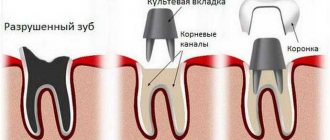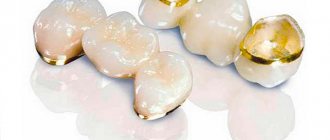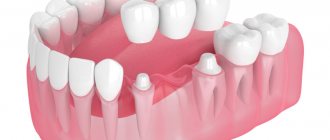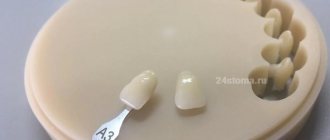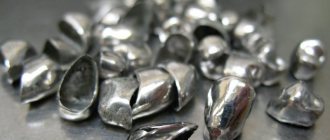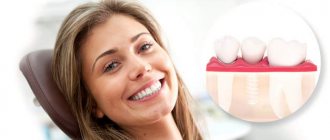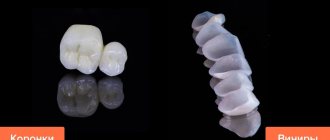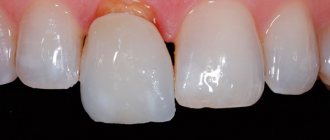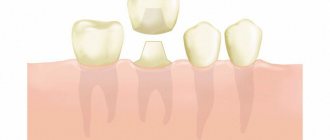In the lateral sections, teeth (molars, premolars) are subject to regular high loads, while their anatomical structure and location in the dentition makes care more difficult. Therefore, chewing units are destroyed faster due to various injuries and dental diseases. Prosthetics of molars and premolars involves the use of structures made of durable, reliable materials that are resistant to severe chewing loads. Dental crowns are orthopedic structures for single restorations, indicated when the upper part of the tooth is destroyed by more than 60%, when the installation of a filling is ineffective.
Types of dental crowns for chewing teeth
Molars and premolars are a kind of millstones that grind food before it enters the esophagus. They experience a high load, which can exceed 75 kg per 1 cm2. Therefore, chewing units are characterized by a massive size, a surface with many protruding tubercles. To restore molars and premolars, strong, reliable materials are used that can withstand increased loads. Orthopedic dentistry offers the following types of crowns for chewing teeth:
- Metal
– durable, corrosion-resistant, service life up to 10-12 years. The list of materials from which these structures are created includes: nickel-chromium alloy, cobalt-chromium alloy, titanium, alloys of noble metals (platinum, silver, gold, palladium). Solid metal alloy prostheses can be coated or not. These are the most inexpensive crowns, but the aesthetics leave much to be desired. Structures containing gold are characterized by high ductility and fit precisely to the tooth stump. The disadvantages of such dentures include excessive abrasion of the antagonist tooth (molar, premolar on the opposite jaw) with constant contact, poor aesthetics, and the development of allergies to the components of the metal alloy (beryllium, chromium, nickel). - Metal-ceramic
- reliable, durable dentures with a metal frame coated with a layer of ceramic mass. Metal-ceramic crowns are quite aesthetic, with an optimal ratio of reasonable price and good quality. Over time, the metal base begins to appear through the gums (gray stripe effect), which negatively affects the aesthetics. Therefore, it is not recommended to place such dentures on teeth along the smile line. - Crowns made of zirconium dioxide
are strong, durable structures that retain their original appearance throughout their service life (more than 15 years). The aesthetics are not inferior to ceramics and provide the tooth with a natural appearance. The biocompatible material is suitable for patients with metal allergies and is used for restoration of the frontal and chewing areas. The structures are manufactured using CAD/CAM technology, on a robotic machine, by milling. This eliminates any errors or inaccuracies, ensures precise fit of the structure to the tooth stump and gum, taking into account the type of jaw closure and the characteristics of the bite. - Metal-plastic
- inexpensive structures, which are a frame made of a metal alloy lined with plastic mass. Due to the porosity of the material, the surface of the prosthesis quickly darkens and absorbs dyes and odors from foods, drinks, and cigarettes. The metal alloy can provoke inflammation and allergies. Service life up to 3 years. Typically, such products are used for temporary prosthetics; they are unreliable as a permanent prosthetic structure.
Ceramic crowns are not suitable for the restoration of molars and premolars. Fragile ceramics are not able to withstand high chewing loads and quickly chip and crack. Ceramic crowns are placed on the front teeth, where the main criterion is high aesthetics. The incisors and canines are not subject to high loads, but participate in the formation of a smile and are visible during conversation. Ceramic restorations are identical to natural enamel in color and transparency and do not stand out from the dentition.
Groups, tooth numbering
There is no unified identification and classification system. Let's consider the basic principles of dividing teeth into groups and designating each.
Numbering of different groups of teeth.
All elements of the upper and lower jaw are divided into frontal and chewing. The frontal elements are designed for biting food and also play an aesthetic role. Chewable ones allow you to crush pieces of food and prepare them for entry into the digestive tract.
There are notation systems:
- square-digital;
- two-digit;
- universal;
- Haderup system;
- alphanumeric.
Square-digital system
Zsigmond-Palmer numbering is common among dentists. Each jaw is conventionally divided into two identical halves, each of which is numbered from 1 to 8. If we talk about a preschool child, Roman numerals from I to V are used, numbering goes from the middle to the edge. Central incisors are assigned the number 1, lateral incisors - No. 2, canines - No. 3, extreme molars - 8. To identify a tooth, its number, jaw, and side of location (right or left) are indicated. This numbering is simple and convenient.
Two-digit numbering
The International Organization of Dentists has recognized a two-digit system. It is a modification of the previous one, more accurate and functional. The numbering used is the same as in the Zsigmond-Palmer system, but the number of the quadrant of the oral cavity in which the tooth is located is additionally indicated. The following designations are used: 1 - right half of the upper jaw, 2 - left half of the upper jaw, 3 - left half of the lower jaw, 4 - right half of the lower jaw. Accordingly, unit number 43 is the right canine of the lower jaw, 21 is the central left incisor of the upper jaw.
Universal
The universal numbering system is the most understandable. Each tooth is assigned a serial number from 1 to 32. Numbering starts from the rightmost upper molar. He is assigned No. 1. Left upper extreme molar - No. 16. The lower jaw is numbered from left to right. It contains teeth No. 17-32. The letters of the Latin alphabet from A to T are used to designate baby teeth.
Alphanumeric
The alphanumeric system is used primarily to describe the characteristics of the bite, since it does not take into account the location of the teeth on the right or left side of the mouth. According to this numbering, the groups are designated by Latin letters: I - incisors, M - molars, C - canines, P - premolars. In addition to the letter, each unit is assigned a serial number. The designation M1 corresponds to the first molar, and I 2 to the extreme incisor.
Haderup system
These designations are similar to the Zsigmond-Palmer classification, but a “+” or “-“ sign is added to the numbers. The first identifies the upper jaw, and the second identifies the lower jaw. To indicate baby teeth, add “0” before each number, for example +02 - the outermost baby incisor on top. This notation system is rarely used.
Stages of installing a crown on a chewing tooth
- Diagnostics
– a comprehensive examination (orthopantomogram, 3D tomography), the dentist determines the general condition of the oral cavity, identifies dental problems, the presence of contraindications, draws up a treatment plan, and selects the optimal orthopedic design. - Preparation
- sanitization of the mouth (removal of plaque, tartar), treatment of teeth and gums (according to indications). The tooth is prepared for covering with a crown - the enamel is prepared, giving the stump the desired shape, the nerve is removed, the canals are filled, and, if necessary, the root is strengthened with a pin or inlay. To install zirconium structures, minimal tissue grinding is required; at the ILATAN clinic, a dental microscope is used for preparation, which allows you to remove enamel within a fraction of a millimeter. - Casts
- the doctor takes impressions of the patient’s jaws, from which a prosthesis is made in the laboratory. To protect the tissue, a temporary plastic crown is fixed to the prepared tooth. - Installation
- the finished crown is tried on, adjusted if necessary and fixed to the support with dental cement.
When are crowns used?
To restore an extracted or damaged tooth that bears a large functional load, a crown is used. This denture is a miniature cap-shaped dental structure that is shaped like the tooth it is replacing. The onlay completely covers the part of the tooth located above the gum.
The best crowns for chewing teeth
Since the main requirements for prosthetics of molars and premolars are the strength and durability of orthopedic systems, the best crowns for chewing teeth are made of zirconium or metal-ceramics. Zirconium is the most durable, lightweight material; installation of such structures requires minimal preparation of the abutment tooth, which is a big advantage over metal-ceramic products. The doctor will decide which restoration to use in a particular case after a detailed assessment of the clinical picture, the characteristics of the patient’s body, his wishes and financial capabilities.
How much do crowns cost in Moscow?
The cost of treatment depends on the complexity of the case, the volume of intervention, restoration material, and manufacturing technology. Installation of metal crowns in Moscow costs on average from 10,000 rubles. per unit, metal ceramics will cost from 15,000 rubles, and a zirconium dioxide crown – from 30,000 rubles.
The ILATAN clinic operates a case payment system, which protects the patient from unexpected expenses and hidden fees. The turnkey price includes all necessary measures for tooth restoration - from consultation to manufacturing and installation of a crown. Treatment of teeth, gums, production and installation of a core inlay, dismantling of old restorations are paid separately. The doctor will announce the exact amount of treatment during the consultation, after examination and diagnosis.
Modern prosthetic options
What kind of prosthetics can a dentist offer if there are no chewing teeth? These can be different types of orthopedic structures - fixed, conditionally removable and classic removable dentures. Let us consider further their features for prosthetics of chewing teeth.
Fixed dentures
The most reliable method of prosthetics for the lower and upper chewing teeth are fixed dentures. Since they are fixed well, they do not fall out of the mouth, and their small size makes it easier to get used to and does not cause nausea or changes in the taste of food. Among the options for permanent prosthetics of chewing teeth, the following can be noted:
- dental inlays: these are micro-prostheses made of ceramic/zirconium dioxide, which are modern analogues of fillings. Microprostheses are used if part of the top of the tooth has broken off or it has been affected by caries (more than a quarter, but less than half) - if a large filling cannot be placed,
- stump inlays: they differ from the previous ones in that they cover not only the apex, but also the root, extending the life of the tooth without a nerve,
- dental crowns: used if the degree of damage to the crown has reached more than 50-60%, or if only the root remains,
- bridge prosthesis: this type of prosthetics is suitable in the absence of 1-3 chewing teeth. The bridge consists of several crowns, the outer ones are fixed on the ground supporting teeth, and the central ones mask the defect and rest against the gums. The downside is that due to the loss of just one tooth, two adjacent ones need to be ground down, even if they are alive and healthy,
- adhesive dental bridge: differs from the previous one in that there are no outermost hollow crowns for installation on supporting teeth, i.e. and no turning of supports is required. The prosthesis is attached to the dentition using special glue due to the lateral “wings”,
- permanent dentures on implants: for a single restoration these are dental crowns on implants, for the restoration of a large number of missing molars and premolars – bridges or segments. In this case, “living” supports are needed, and the structures are securely fixed only on implants, which make it possible to extend their service life by at least twice.
Zirconium dioxide crown on an implant for all 55,000 rubles instead of 80,000 rubles!
OSSTEM implant (South Korea), individual zirconium abutment, gum former, impression taking.
Creation of a Prettau zirconium crown using 3D modeling technology. Consultation with 2 doctors: an orthopedist and an implantologist for free! Call now or request a call
Opening hours: 24 hours a day - seven days a week
Removable dentures
In the absence of several molars or premolars, the presence of terminal defects, during preparation for implantation or after it, removable dentures are often offered. These can be clasp1 designs - on hooks, on attachments or on telescopic crowns. And also dentures made of plastic or immediate dentures instead of 1-2 chewing teeth, acrylic, Acry-free, nylon, Quattro Ti, polyurethane.
Clasp ones have a metal base and are quite securely fixed in the oral cavity. Plastic ones are basically a cheaper option for prosthetics of chewing teeth (but also less reliable). Plastic dentures are attached to adjacent teeth using clasps (hooks), and can also additionally contain a large palatal bridge or massive artificial gum on the lower jaw.
Conditionally removable structures
Conditionally removable, as a rule, are installed with a completely toothless jaw, but an option is possible when it replaces segments and sectors. The essence of conditionally removable prosthetics is that the prosthesis is fixed on implants, but at the same time it can be removed independently if necessary (although it occurs very rarely), but it is better for the removal to be carried out by a dentist. This method differs from fixed prostheses on implants in the type and durability of the fastening - in conditionally removable ones, it becomes loose over time, and the prosthesis begins to shift. Less often, such dentures are fixed on 2-4 supporting teeth, of which only the roots remain - they are strengthened with special metal locks.
Alternative options to frontal crowns
At the moment, there are three alternative methods that allow you to restore the crown part of the tooth, with destruction of no more than 50%. These include:
- Veneers. Suitable for use if there is slight destruction of the outer surface of one of the front teeth. An important requirement for carrying out a procedure using such plates is the preservation of the tooth wall from the inside. Through veneers, unsurpassed aesthetics are achieved, the possibility of tooth preservation is ensured and it is possible to significantly extend the life of the tooth;
- Dental implants. If it is necessary to reconstruct 1-2 teeth and install bridge-like prosthetic devices, it is advisable to fix the implants instead of preparing the supporting units;
- Filling material. As mentioned earlier, the option with light-composite restorations is preferable when the coronal part of the tooth is destroyed by no more than 50%.
Filling as part of caries treatment
The cause of molar destruction is most often caries, which usually develops due to abundant accumulations of plaque and hard deposits - the result of insufficient cleaning and hygiene. As a result, the tooth gradually deteriorates, and before the infection reaches the nerve, it is important to begin treatment as soon as possible. At the appointment, the dentist will remove all necrotic and damaged tissue, perform an antiseptic treatment and begin restoring the integrity of the crown.
Source: dentalperfection.in
Today, modern photopolymer materials are used for this purpose - such composites harden under the influence of a special polymerizing lamp. This property allows you to apply the material in layers to return the crown to its original appearance - it helps to recreate the anatomical relief as accurately as possible to restore the aesthetics and functionality of the tooth. In addition, photopolymers are durable and wear-resistant - their service life can reach 20 years, of course, with proper and regular care.
How to install
First, the prosthetic structure must be manufactured. To do this, the patient undergoes sanitation of the oral cavity, X-ray examination of the jaws, installation of implants (if required), and taking impressions of the dentition. Next, the production of the denture begins, which can take from 1-2 days to a month - it all depends on the workload of the dental laboratory. As for classic removable and non-removable products, the patient comes 1-2 more times to try on the model according to which the prosthesis will be made. If the crown or bridge will be fixed on implants, and precise computer equipment is used to make them, then fitting is not necessary.
Don't know what type of prosthetics to choose?
We will help in the selection, advise where to read more information and compare types of prosthetics.
Consultation with an orthopedic doctor in Moscow clinics is free! Call now or request a call
Working hours: from 9:00 to 21:00 - seven days a week
When the product is ready, it is installed on the patient (the method depends on the type of prosthesis) and recommendations for wearing and care are given.
Advantages and disadvantages of crowns
Ceramics are aesthetically pleasing for the restoration of anterior teeth. But they cannot stand temperature changes - you should not drink ice cream with hot tea. The advantage of such crowns is hypoallergenicity and immunity to dyes. You can safely eat berries, drink juice or coffee. The material will not be stained.
In dental practice, high-temperature ceramics are common - hardened under the influence of heat in a muffle. Such crowns will last 10 years or more. The material is more expensive than metal ceramics, but cheaper than zirconium dioxide. Minimal grinding of the tooth is required, so the “nerve” can be preserved. Sometimes the crown looks more presentable than the adjacent natural teeth. Then veneers are installed on the front teeth. Maximum – 10 on top and 8 on bottom.
Metal ceramics and zirconium dioxide will help restore the segment of chewing teeth. Metal-free models are more expensive to install, but their cost is recouped by their service life. They don't need repairs. When using cermets, chips and cracks in the surface coating are possible, but zirconium dioxide will not present such a “surprise”. Additional criteria:
- A metal-free prosthesis fits better, follows the anatomical shape of the tooth and takes into account the characteristics of the bite to a higher degree than a metal frame.
- Familiarity and comfort. Zirconium is characterized by low weight and maximum smoothness.
Your dentist will tell you which crowns are best to place in your case. There are nuances: quick prosthetics of two, three or more teeth without allergic reactions at a budget price is possible when using metal-ceramic structures. They can be easily replaced later with better rated ones.
If you prefer the best in everything, are ready to pay for quality and solve the problem for decades, or your teeth are characterized by pathological abrasion, then your option is a zirconium analogue. Metal-ceramics are often installed on pulpless teeth, and zirconium crowns can be used to save a “living” unit.
How to properly care for orthopedic structures
Usually the dentist talks about the rules of care after prosthetics. The easiest way to care for fixed crowns and bridges (including those on implants) is to clean them twice a day with a soft or medium-hard brush and a paste without scratching particles. You should also visit the dentist 1-2 times a year for examination and prevention.
With removable structures it is more difficult - they must not only be cleaned with a brush with a special paste, but also constantly removed from the mouth for rinsing (usually after eating). They also need to be disinfected in a special solution once every 1-2 weeks. You will have to visit the clinic 3-4 times a year, because... The prosthesis will have to be adjusted and relined regularly.
